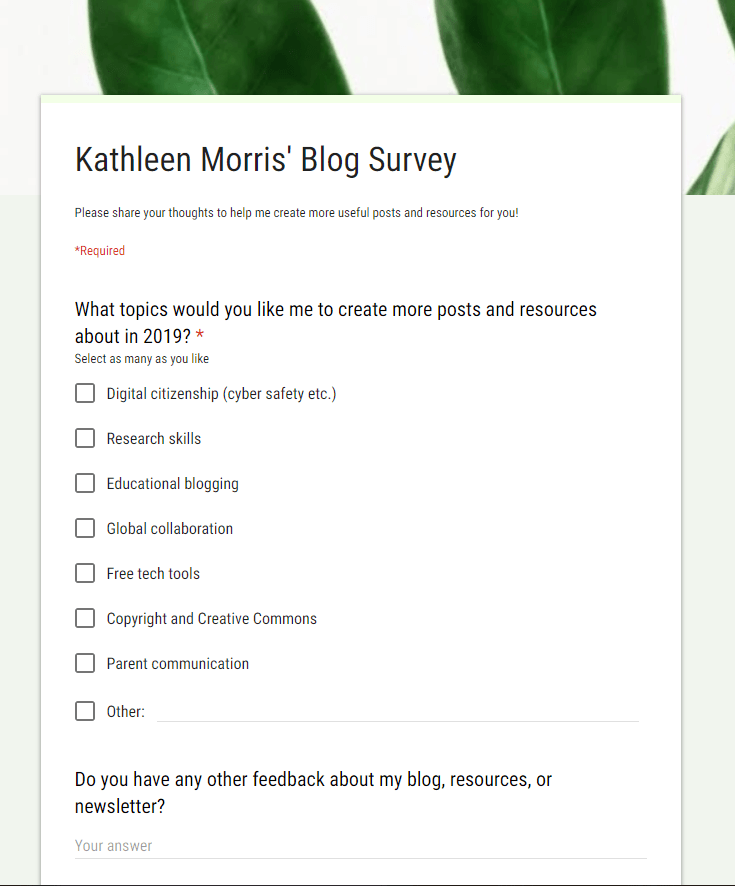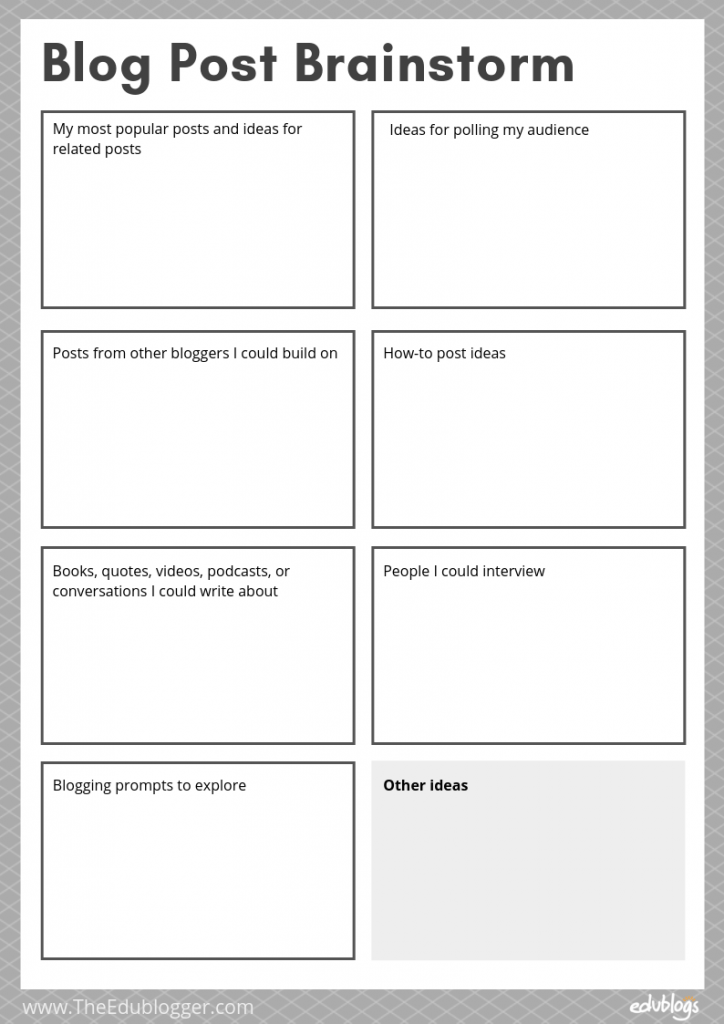There are two types of bloggers.
One has a never-ending list of blog post ideas but just can’t find the time to write them all. The other wants to write more blog posts but is stuck for ideas.
Which type of blogger are you?
If you’re the latter, you’re in luck. This post offers you 7 ideas to help you find inspiration for your future blog posts.
These ideas apply to both student and teacher bloggers.
Scroll down for a printable worksheet where you can jot down your ideas as you read through the post.
(Tip: If you have the ideas but not the time, check out our Plan For Writing A Weekly Blog Post In 10 Minutes A Day).
1) What are your most popular posts?
We don’t always write blog posts just for an audience. Blogging is a great way to reflect and document your thinking.
However, many bloggers enjoy the benefits of having an authentic audience. So a great place to start is finding out which of your posts have resonated with your audience in the past.
If you use Edublogs Pro or CampusPress, the ideal way to do this is via Google Analytics.
These instructions explain how to set up Google Analytics and you’ll be able to access your data via the Google Analytics website, or app.
You’ll also be able to check out a snapshot of your most popular posts by going to Dashboard > Statistics.
Once you know what your most popular posts are, ask yourself:
- What else could I write on that same topic?
- Could I break down the topic further? For example, if you wrote an overview of teaching geometry to 8th graders, could you break it down and share a sequence of detailed lesson plans, assessments, or resources?
- Is there a style of post that’s been popular with readers? Have you written some “top 10” posts or “how-to” posts or “comparison” posts that have done well? Could you write more posts in a similar style?
- Could you re-purpose some of your old content into a different format? For example, could you turn one of your popular posts into a video, slideshow, checklist, graphic, etc?
2) Poll your audience
If you’ve been blogging for a while and have built an audience for your blog, consider asking your readers what they’d like you to write about.
Google Forms is a great way to make a simple survey but there are other tools available such as Crowdsignal (formerly called Polldaddy).
Keep the survey as simple as possible so busy readers don’t feel reluctant to submit a response.
Example: Google Forms
At the end of last year, I polled my own readers on my blog to find out what topics they’re most interested in. I also included an option to write any other feedback (38% of readers added additional information while 62% of readers just used the checklist).
The responses and trends were insightful.
This is what the poll looked like (the poll is no longer live so this is just an image).

3) Build on someone else’s blog post
If you’re a blogger, you probably read other people’s blog posts as well. This is an important part of the blogging process. Reading other blogs not only helps you develop your thinking but helps you become part of an online community.
Have you ever read a blog post that really got you thinking? You might be left with a lot of unanswered questions or you might simply feel like you have more to add to the conversation.
You could leave a blog comment or you could expand on the topic even further by writing a blog post.
Examples
- A teacher might read a blog post about flexible seating. This teacher might be trying out some flexible seating options in their own classroom. They could write a post to share their approach along with some images.
- A student might read another student’s post about their trick for learning times tables. The student might have their own tricks they use which they could share in their own blog post.
Remember to link back to the inspiration for your blog post and when it’s published reach out and tell the blogger about it. The blogger might like to continue the conversation with you further or share your post with their own network.
4) Write a how-to
As Derek Sivers says,
What’s obvious to you is amazing to others.
It’s true! There’s a lot you know about or have had experience with. It might not seem like anything overly special but it could really help your readers.
How-to posts are often popular as they help your readers overcome their problems. Your helpful post is likely to stick in a reader’s mind and they may become a loyal and regular visitor to your blog.
How can you make a how-to post?
- Write out the steps and include images.
- Make a video tutorial or a screencast using a tool like Loom or Screencastify.
- Make a checklist.
- Create a diagram or other type of graphic (Canva is a great tool for this).
5) Share something from your life
What’s been happening in your life lately? You don’t have to have been doing anything extraordinary to create an interesting blog post.
Have you read a book? Write a review or share some takeaways.
Have you come across an interesting quote? Share the quote with your readers and explain what it means to you.
Have you watched a thought-provoking movie, tv show, or video? Or perhaps you have listened to an interesting podcast? Tell your audience about it. How did it change your thinking? What has it left you curious about?
Have you had an interesting conversation with someone? Whether or not your conversation was on the web or in real life, is there anything you could share with your audience?
You might even reflect back on a book, quote, video, podcast, or conversation that you engaged with long ago. Why has it stuck in your mind?
6) Interview someone
Interviews with others can make interesting blog posts. You and your audience might learn a lot and gain new insights!
You can interview someone via video or an audio recording, but the simplest way to do it is by writing out the questions and answers.
Tip: Make sure the questions and answers stand out in the body of the text; use bold, dark colors, or headings.
If you’re interested in interviewing someone on your blog, here are a few steps to follow:
- Research. Consider why you want to interview the person. Decide what sort of questions you’d like to ask them.
- Request. Ask the person face-to-face or via a polite email and explain what you’d like to interview them about.
- Conduct the interview. If you can meet with the person face-to-face, you might like to type their responses out as you talk to them. If not, send the questions via email and give the person a guide on how much information you’re after for each question and when you need it by.
- Add an introduction and conclusion. Your blog post will need context so write an introduction that tells your reader about the interviewee. Don’t forget to link to the interviewee’s site if they have one. Your conclusion might include your own takeaways on what you learned or a call to action (suggesting readers visit the interviewee’s blog or follow them on social media).
- Revise. After you’ve drafted the interview post, share it with the interviewee and ask them if there is anything they’d like to change. Tip: Public Post Preview plugin can be handy here.
- Publish the post. Share the post with your network and invite the interviewee to do the same.
7) Use blogging prompts
Many bloggers enjoy coming up with lists of blogging prompts and these can be a great way to get ideas!
We’ve published a number of these lists on The Edublogger. Here are four for teachers and students:
- 50 Blog Post Ideas For Educators (2018)
- 50 Blog Post Ideas For Students (2018)
- 50 Blog Topics And Prompts For Teachers (2017)
- 100+ Ideas And Prompts For Student Blogging (2017)
Students might also be interested in checking out the work of John Spencer. He has recently released a fantastic PowerPoint full of creative writing prompts to his community.
Check out the preview below and access the full collection of prompts here.
John also has some excellent creative writing prompts on YouTube. Students could embed a video prompt in a post and then write their response.
Here’s an example,
Take Action — Start Brainstorming
Are you now full of ideas for future blog posts? I hope so.
Don’t let those ideas go!
Why not print off our brainstorming sheet now and jot down your thoughts?
>>Download the PDF

When you’re done, you could keep your brainstorming sheet by your desk and use your blog post ideas throughout the coming months. Or you might like to transfer your ideas to a Google Doc, diary, or editorial calendar.
Over To You
What other ideas do you have?
Where do you find inspiration for your own blog posts? How do you keep track of your ideas?
We’d love to hear from you. Please leave a comment below!
Related Reading
A Plan For Writing A Weekly Blog Post In 10 Minutes A Day



I have enjoyed reading your blog. I have learned so much, I was taking some notes that will help me in starting my blog. I want to write about my BA educational experiences plus I just want to practice my writing skills.
Thanks that was so helpful
thank youi am new to the commuty
This Blog is very helpful and it helps me understand what it is about so thank you Kathrenn morris.
YAY These ideas are so helpful for my blogs please do more
I loved your post, it was so helpful, you need to write another great post like this one. It was amazing to read. 🙂 :0
I am a “want to wright more but stuck for ideas” sort of writer so while I think what to write I usually comment on other people’s blogs and then after that I have something that pops into my head and hay presto I know exactly what to write !!!
This blog really gives us ideas and good Inspiration Info!
ok
amazing
This is a very good blog post!